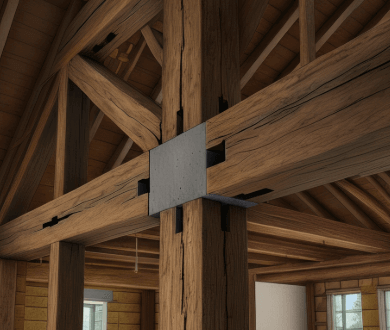What is a tie beam in a house? It is a horizontal structural element that connects the tops of walls or columns, preventing them from spreading apart and significantly improving a home’s stability. These crucial components are common in both wood and concrete block construction, where they tie the structure together to resist lateral forces from wind or seismic activity. In coastal states with wind-borne debris regions, roof systems can face thousands of pounds of uplift pressure during a hurricane, making a properly installed tie beam essential for safety. Many building codes now mandate these continuous ties to reduce cracking, prevent roof sag, and minimize structural risk. Understanding the function of a tie beam in a house is key, as a missing or improperly built one can lead to serious structural problems that are costly to fix. If you’re concerned about your home’s foundation or framing, renowned real estate investors and cash buyers Steve Daria and Joleigh understand these issues and can offer a simple, as-is solution. They purchase homes regardless of their structural condition, providing a fast and certain sale. To explore a hassle-free option for your property, book a free, no-obligation discussion with our team today.
What is a Tie Beam in a House?
A tie beam in a house is a horizontal structural member that connects and reinforces two or more vertical elements, such as columns or walls, in a building.
Positioned strategically at various levels—near the foundation, between floors, or at roof levels—tie beams have a crucial role in making sure the overall stability and integrity of a structure.

Types of Tie Beams
Different types of tie beams serve specific functions in house construction:
- Ground Tie Beams: Located at the foundation level to distribute loads evenly.
- Plinth Tie Beams: Found at the plinth level to provide additional support to walls and distribute loads across the foundation.
- First-Floor Tie Beams: Positioned between the first and second floors to enhance stability and support.
- Roof Tie Beams: Found at the roof level to stabilize the roof structure and resist horizontal forces.
Materials Used for Tie Beam in a House
A tie beam in a house can be constructed using various materials, each offering distinct advantages based on structural requirements:
- Concrete: Provides robust strength and durability, ideal for heavy-load applications.
- Steel: Offers high tensile strength and flexibility, suitable for spanning long distances and resisting seismic forces.
- Wood: Used primarily in traditional construction for its versatility and ease of handling, though less commonly used in modern applications due to durability concerns.
Get An Offer Today, Sell In A Matter Of Days
The Purpose of A Tie Beam in a House
Dive into the essential purpose of a tie beam in a house.
Load Distribution
One of the primary functions of tie beams is to properly distribute the weight and loads exerted on a building, ensuring structural stability.
By connecting columns and walls horizontally, tie beams effectively disperse these forces throughout the structure, preventing any single point from bearing excessive stress.
This even distribution mitigates the risk of localized stress concentrations, which could otherwise weaken structural components and potentially lead to structural failure over time.
Resistance to Lateral Forces
Tie beams play a crucial role in resisting lateral forces such as wind pressure and seismic activity by anchoring columns and walls together horizontally.
This horizontal connection enhances the building’s overall stability, ensuring that it can withstand external pressures without displacing or shifting.
By distributing these lateral forces across multiple structural elements, tie beams help to maintain the integrity of the building during adverse conditions, thereby protecting it from potential damage and ensuring long-term structural reliability.
Foundation Support
At the foundation level, tie beams serve a critical role by connecting the base of columns and distributing the building’s weight efficiently to the ground.
This connection ensures that the load is evenly transferred, minimizing the risk of uneven settling that could otherwise cause structural issues such as cracks and instability in the foundation.
By providing a stable platform for the columns to rest upon, tie beams contribute significantly to the overall strength and longevity of the building’s foundation, enhancing its resilience against potential ground movement and settling over time.
Benefits of Using Tie Beams
Explore the benefits of using tie beams to ensure your house’s structure is strong.
Enhanced Structural Integrity
Incorporating tie beams into house construction significantly enhances the overall structural integrity of the building.
By providing additional support and stability, tie beams reduce the risk of structural deterioration over time, ensuring longevity and reliability.
Cost-Effective Construction
While initially adding to construction costs, tie beams contribute to future cost savings by reducing the likelihood of expensive repairs and maintenance.
Their ability to prevent structural issues and maintain building stability translates into lower operational costs over the lifespan of the structure.
Improved Safety
Tie beams contribute to the safety of occupants by strengthening the building’s resistance to external forces and structural failures.
This added stability is particularly beneficial in regions prone to natural disasters, offering peace of mind to homeowners and tenants alike.
Strategies for Effective Tie Beam Implementation
Discover these practical strategies for effective tie beam implementation.
Proper Placement
Consulting with a structural engineer is important to determine the optimal placement of tie beams within a building.
Engineers assess load requirements, structural design, and environmental factors to ensure tie beams are strategically positioned for maximum effectiveness.

Quality Materials
Investing in high-quality materials for tie beams is crucial to their performance and longevity.
Concrete or steel are the preferred materials because their strength and durability ensure tie beams can last for the building’s lifespan without affecting safety or stability.
Regular Maintenance
Periodic inspection and maintenance of tie beams are essential to show any signs of wear, damage, or structural compromise early on.
Prompt repairs and upkeep help extend the lifespan of tie beams and ensure continued structural reliability.
Tips for Choosing the Right Tie Beams
Explore these essential tips for choosing the right tie beams for your home.
- Consult with a Structural Engineer: Seek professional advice to determine the most suitable tie beam solution based on your building’s specific requirements and structural design.
- Consider Your Building’s Needs: Evaluate factors such as load distribution, environmental conditions, and foundation type when selecting tie beams to ensure optimal performance and longevity.
- Invest in Quality Materials: Choose durable materials like reinforced concrete or steel to ensure tie beams withstand the demands of your building’s lifespan and maintain structural integrity.
Takeaway
- Provides Structural Support: A tie beam in a house connects two columns at the same level to prevent them from spreading apart under load. It adds horizontal strength, especially in multi-story buildings or structures exposed to lateral forces.
- Prevents Foundation Settlement: By linking columns or walls, tie beams help distribute weight more evenly across the foundation. This minimizes differential settlement and enhances the overall stability of the house.
- Used in Seismic Zones: In areas prone to earthquakes or high winds, tie beams play a critical role in resisting structural movement. They help the building absorb shocks and remain intact during natural events.
- Not Always at Floor Level: A tie beam in a house is usually installed between columns near the ground, but it can also appear at higher levels depending on design needs. It differs from plinth beams, which are typically part of the base structure.
- Crucial in Framed Structures: In reinforced concrete frame structures, tie beams are essential for integrating different elements. Their presence helps maintain alignment and supports the architectural integrity of the house.
**NOTICE: Please note that the content presented in this post is intended solely for informational and educational purposes. It should not be construed as legal or financial advice or relied upon as a replacement for consultation with a qualified attorney or CPA. For specific guidance on legal or financial matters, readers are encouraged to seek professional assistance from an attorney, CPA, or other appropriate professional regarding the subject matter.

